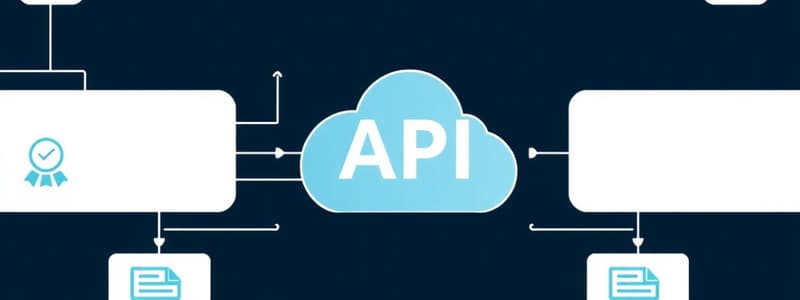Podcast
Questions and Answers
What is the primary benefit of microservices architecture?
What is the primary benefit of microservices architecture?
- Simplified full application redeployment
- Independent scaling of individual services (correct)
- Tighter coupling of components
- Increased vulnerability to failures
Monolithic applications offer better scaling flexibility compared to microservices.
Monolithic applications offer better scaling flexibility compared to microservices.
False (B)
Name one key benefit of using microservices architecture in IoT applications.
Name one key benefit of using microservices architecture in IoT applications.
Scalability
In microservices architecture, communication between services typically occurs via REST APIs or ______.
In microservices architecture, communication between services typically occurs via REST APIs or ______.
Match each scaling type with its description:
Match each scaling type with its description:
Which scaling approach is limited by physical constraints and not commonly used in IoT due to large event volumes?
Which scaling approach is limited by physical constraints and not commonly used in IoT due to large event volumes?
Verb-based decomposition is generally more suitable for IoT applications than noun-based decomposition.
Verb-based decomposition is generally more suitable for IoT applications than noun-based decomposition.
What is the advantage of using PaaS for deploying microservices in IoT applications?
What is the advantage of using PaaS for deploying microservices in IoT applications?
______ scaling involves distributing workloads across multiple instances of an application or microservices.
______ scaling involves distributing workloads across multiple instances of an application or microservices.
Which of the following is NOT a benefit of using microservices?
Which of the following is NOT a benefit of using microservices?
Z-axis scaling improves cache utilization and reduces memory usage.
Z-axis scaling improves cache utilization and reduces memory usage.
Name one drawback of Z-axis scaling.
Name one drawback of Z-axis scaling.
Microservices can address device heterogeneity by implementing services as ______ that handle different communication protocols.
Microservices can address device heterogeneity by implementing services as ______ that handle different communication protocols.
What is the primary reason that verb-based decomposition is less suitable for IoT applications?
What is the primary reason that verb-based decomposition is less suitable for IoT applications?
Match the scaling type to its corresponding feature:
Match the scaling type to its corresponding feature:
In a microservices architecture, a failure in one microservice always leads to the failure of the entire system.
In a microservices architecture, a failure in one microservice always leads to the failure of the entire system.
In Z-axis scaling, what is the primary criterion for routing requests to a specific server?
In Z-axis scaling, what is the primary criterion for routing requests to a specific server?
What type of architecture bundles all components together, leading to scaling inflexibility, update complexity, and higher vulnerability?
What type of architecture bundles all components together, leading to scaling inflexibility, update complexity, and higher vulnerability?
Effective use of microservices requires careful ______ to minimize inter-service dependencies.
Effective use of microservices requires careful ______ to minimize inter-service dependencies.
Which of the following is a disadvantage of Y-axis scaling?
Which of the following is a disadvantage of Y-axis scaling?
Flashcards
Microservices Architecture
Microservices Architecture
Breaks applications into small, independent services, each with a specific function, that can be independently developed, deployed, and scaled.
Monolithic Applications
Monolithic Applications
Components are bundled together, leading to scaling inflexibility and update complexity.
Microservices in IoT
Microservices in IoT
Ensures continued operation even if individual services fail.
Why use Microservices in IoT?
Why use Microservices in IoT?
Signup and view all the flashcards
Verb-based Decomposition
Verb-based Decomposition
Signup and view all the flashcards
Noun-based Decomposition
Noun-based Decomposition
Signup and view all the flashcards
PaaS (Platform as a Service)
PaaS (Platform as a Service)
Signup and view all the flashcards
Vertical Scaling
Vertical Scaling
Signup and view all the flashcards
Horizontal Scaling
Horizontal Scaling
Signup and view all the flashcards
X-axis Scaling
X-axis Scaling
Signup and view all the flashcards
Y-axis Scaling
Y-axis Scaling
Signup and view all the flashcards
Z-axis Scaling
Z-axis Scaling
Signup and view all the flashcards
Study Notes
- Microservices architecture divides applications into small, independent, function-specific services.
- Each microservice operates in its own process, enabling independent development, deployment, scaling, and upgrades.
- Microservices are resource-efficient, and allow for optimal scaling based on workload.
- Microservices can be built using different technologies for different services.
- Updates to a microservice require only that service to be updated, without redeploying the entire application.
- Communication in microservices primarily occurs through REST APIs or RPCs but should be minimized due to performance costs.
- Microservices avoid full redeployment on updates, scale specific parts of the app based on load, and offer better fault isolation compared to monolithic architecture.
- Monolithic apps bundle all components, which leads to scaling inflexibility, update complexity, and higher vulnerability.
- For effective microservices, componentization to minimize inter-service dependencies is required.
- Microservices in IoT ensure continued operation of the broader system even if individual services fail.
Microservices for IoT Applications
- Microservices are suited for IoT applications due to their scalability advantages over monolithic designs.
- Microservices-based applications are broken down into independent services, each running in its own process, which can be deployed and scaled independently.
- Device heterogeneity can be solved using microservices, with services acting as proxies to manage diverse communication protocols like Wi-Fi, LoRa, and BLE.
- Verb-based decomposition revolves around use cases, however, is less suited for IoT applications.
- Noun-based decomposition revolves around specific functionality, and enables separate scaling of each function.
- A hybrid approach combines both verb-based and noun-based strategies.
- Fault tolerance is enhanced, and failures in one microservice do not take down the entire system.
Microservices Scaling
- PaaS (Platform as a Service) simplifies microservices deployment, resource management, and scalability, and is therefore well suited for IoT applications.
- Vertical Scaling adds more resources to an IoT node, but is uncommon in IoT due to event volumes.
- Horizontal Scaling distributes workloads across multiple application or microservices instances.
- X-axis scaling involves creating multiple instances of an application or microservice, each handling part of the workload.
- Y-axis scaling splits the application into different services based on functionality.
- Z-axis scaling runs identical code on each server but handles a subset of the data, routing requests based on user categories.
- Automatic Scaling: Some PaaS providers offer automatic scaling, adjusting microservices based on real-time workload demands.
- Z-axis scaling improves cache utilization, reduces memory usage and I/O traffic, and provides better fault isolation.
- Increased application complexity and the challenge of implementing effective data partitioning are drawbacks of Z-axis Scaling.
Studying That Suits You
Use AI to generate personalized quizzes and flashcards to suit your learning preferences.




